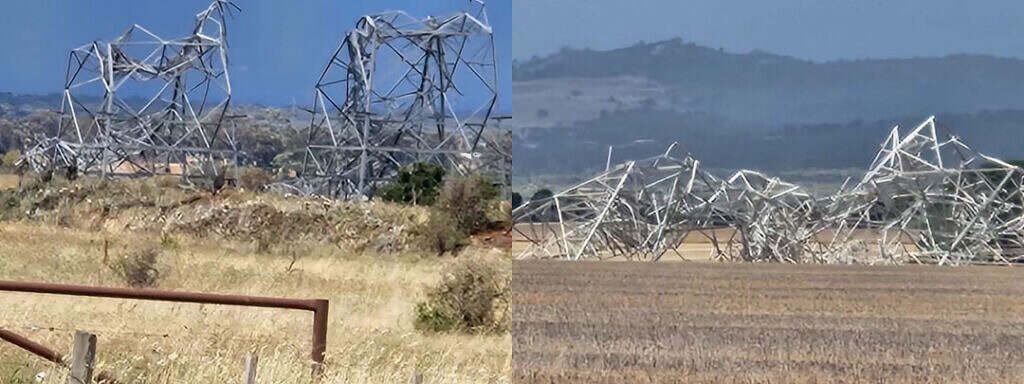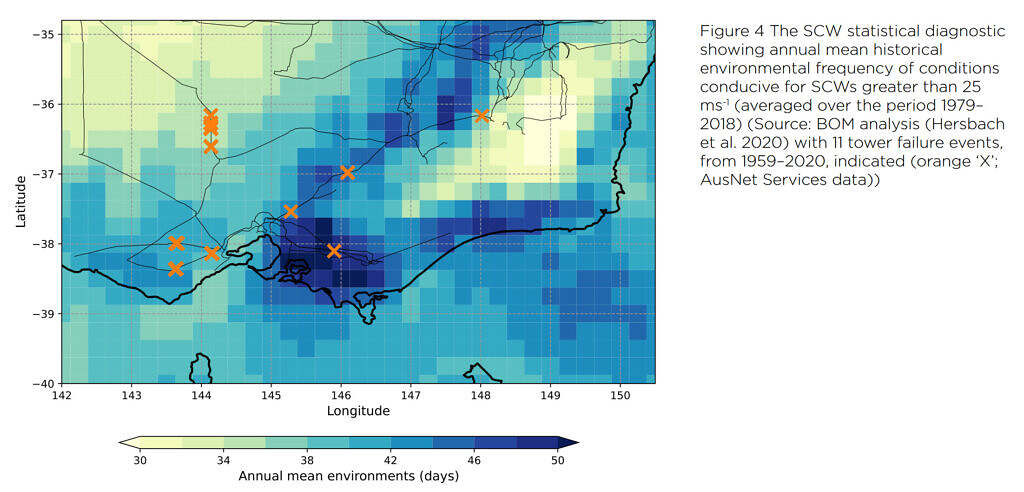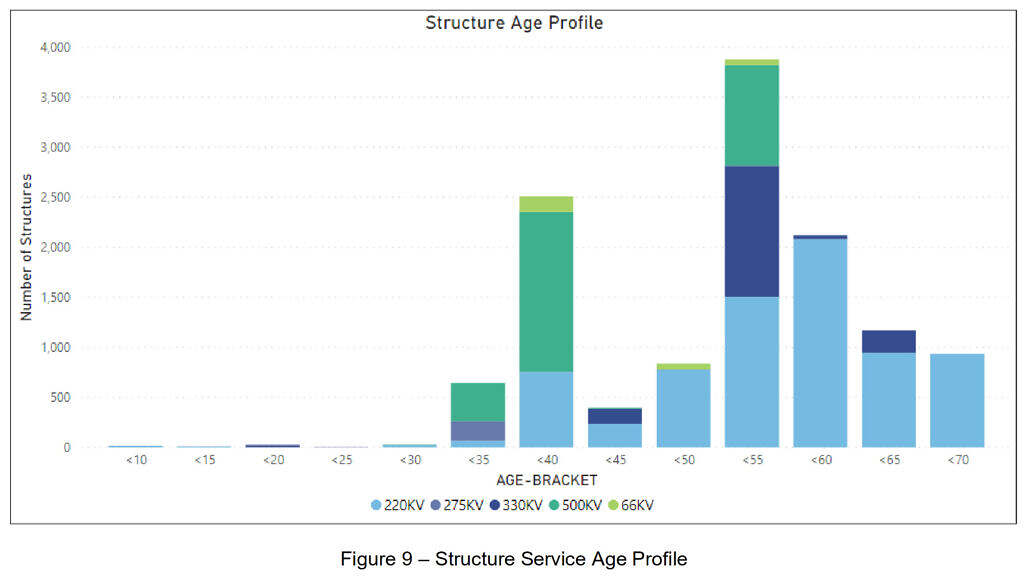Photographs of the downed towers near Geelong have appeared across the mainstream media this morning – following yesterday’s significant power system event in Victoria that resulted in power losses for hundreds of thousands of customers across the state. It’s now clear that six towers in total collapsed due to strong wind speeds – the images below have been supplied to us by one WattClarity reader.

In December 2022 I wrote the piece How common are islandings and transmission tower failures in the NEM? here on WattClarity, where I attempted to compile a reference list of every single event that resulted in a transmission tower failure or collapse in the history of the NEM (up until that point).
As I noted on LinkedIn yesterday afternoon, this appears to be the 6th occurrence of a tower failure in the NEM since 2020 – whereas I could only find 9 such instances of this happening in the 20 years prior. The resulting discussion suggests that at least two factors may be involved with this apparent trend: 1) the increasing frequency of severe convective winds, and 2) the aging state of transmission structures.
Severe Convective Winds
Some online users have suggested to me that severe convective winds (or downdrafts) have been increasing in frequency in Australia in recent years – and are projected to increase over time. The ESCI (a project funded by the Federal Government, CSIRO, AEMO, and AusNet Services) published this very useful fact sheet in July 2021 that explains the threat of severe convective winds to the NEM’s transmission infrastructure – with a specific focus on Victoria’s network.

Location of tower failure events between 1959 and 2020 in Victoria compared to environmental conditions conducive for Severe Convective Winds. Note that AusNet Services have attributed the four tower collapses on the Bendigo to Kerang 220 kV line (-36.5 , 144) to tower design inadequacy.
Source: Electricity Sector Climate Information Project, July 2021
It is also worth noting a recently published academic paper on long-term observations of severe convective winds across Australia from a team of researchers at the University of Melbourne and the Bureau of Meteorology.
An aging transmission network
As I noted in my prior article, much of Victoria’s transmission network consists of structures originally designed between the 1960s and 1980s – with the average structure age assumed to be well past 50 years in 2024.

Age brackets of the AusNet Services transmission structures (as of July 2020). The expected service life for structures is approximately 70 years.
Source: AusNet Services, July 2020
The full July 2020 report showed that Victoria’s 500kV structures are slightly younger than those within the rest of the network. And the vast majority of the 500kV structures exhibited conditions classed as ‘Good’ – which is described as ‘first rust spots appear’ on either bolt & nut, steel member, brace, or poles within the structure.
The aforementioned ESCI report from July 2021 concluded “Maintenance and upgrades consider several factors, including exposure, history of failure and physical condition of the tower, but generally towers are not systematically upgraded to today’s engineering standards.”
Questions to think through
The extent to which both wind conditions and network age (i.e. structural adequacy) were factors in the tower collapse is still up in the air. I will leave that to be debated amongst the atmospheric physicists and the civil engineers.
But yesterday’s events and the possible growing trend of tower failures have posed more questions from others in our team, such as:
- What does this mean in terms of planning with respect to VNI-West?
- How should these High Impact-Low Probability events be captured in the RIT-T process?
- How does this impact AEMO’s long-term modeling? Specifically, assumptions regarding network reliability.
- How many existing transmission towers in the NEM should be reassessed/redeveloped for improved resilience to severe convective winds?
- And to what extent are consumers ready and willing to pay for this improved resilience?
- Many others..


The article correctly highlights the age of the electrical transmission infrastructure in SE Australia, and the many failures from severe convective winds that are occurring. However, a factor that is often overlooked is the need to design for the particular characteristics of convective winds in comparison with those of larger synoptic scale wind events for which the older systems were designed, often based on methods developed overseas in much different wind climates. In layman’s terms, the convective wind events generate a single large gust that envelopes 3 or more spans, and results in the failure of several towers in a group as we saw on February 13. The result of this is that a convective wind event with a peak gust of say 140 km/h can generate wind loads on a span 50% higher than those from a large-scale synoptic wind event with the same maximum gust. It is essential that design methods for wind loading accounting for these characteristics are adopted for the new transmission lines under construction and planned for the energy transmission.
Another question wotth investigating is whether the wind and solar farms are actually negatively impacting the climate by producing more volatile systems.
factors in the tower collapse “still up in the air” I see what you did there 🙂
Was it just wind? Or was there a hail loading as well?
Safety factors incorporated at the time these existing transmission towers were being designed were doubtless higher than those applied today. Nothing wrong with that since today’s material quality standards are superior and support lower safety factors. If heavier cables have been strung, that would test any ageing components.
The Sydney Harbour Bridge, West Gate Bridge, etc, should probably be reassessed against today’s operating circumstances with heavier trucks and more of them etc.
Who is auditing the condition of this ageing infrastructure?
The tree’s in background look fine begs the question the quality and the integrity of the steel and design of the tower’s I Wonder where they where made and designed??.
I believe there is an electrical/magnetic component involved, as current is passed through the cables it essentially turns it into a “motor” which the geomagnetic storm twists the towers, generating a great amount of torque on the frames.
Network charges on our Electricity bills have been rising ever higher ,year on year to such an extent experts and many in the know have termed all the money being charged as ” Gold Plating the Network” suggesting …consumers are and have been paying too much money in their bills to justify the cost of keeping the grid and networks operating optimally.
NOW…this article suggests that major network infrastructure…Electricity Distribution Towers…at least in Victoria is averaging an age of 50 years+ and as such in some areas is reaching it’s expected life span!
SO… Why have consumers been paying higher and higher prices for Network Charges that are supposed to be needed to keep the Network/Grid in peak shape…and yet have major aspects of that grid / network reaching their life span ? Where has and is all that money for gold plating gone ?? And where and what has it been spent on ?
You CAN’T charge Network / Distribution costs that are supposed to keep things in peak condition , up to date and modernised …justifying the high charges being paid …YET here is an example of Network Infrastructure that HAS NOT been maintained and /or replaced since or before the Introduction of our Decimal Currency in 1966!!!
Where has the money gone ???!?
Brett, the investment has largely been in new lines and upgrading existing lines to connect renewables to the NEM.
So we have had billions spent and the network is now less reliable than it was before because we have much more distributed power generation that relies on flimsy line infrastructure.